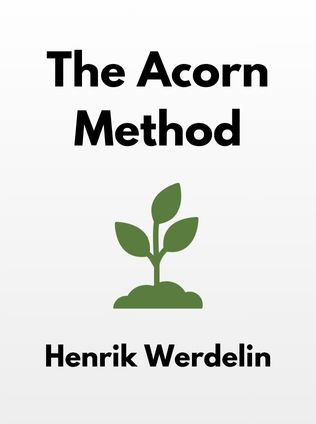
The Acorn Method
How Companies Get Growing Again
By Henrik Werdelin
Published 04/2020
About the Author
Henrik Werdelin is an accomplished entrepreneur and innovator, renowned for his ability to breathe new life into mature companies through groundbreaking business methodologies. He is the co-founder of America’s fastest-growing pet brand, BARK, known for its popular subscription service, BarkBox. Additionally, Werdelin is a founding partner of Prehype, an international organization that collaborates with entrepreneurs and established companies to build new ventures. His entrepreneurial prowess extends to startups that have been acquired by giants such as Facebook and Microsoft. He has also provided valuable advice to notable companies including Coca-Cola, LEGO, CitiGroup, Intel, and Verizon. Originally from Denmark, Werdelin now resides in New York with his family, continuing to share his innovative strategies through teaching at institutions like Stanford and through features in prominent publications such as Harvard Business Review and Bloomberg.
Main Idea
The central premise of "The Acorn Method" by Henrik Werdelin is a transformative approach to revitalize mature companies by leveraging their existing strengths to create new, innovative business ventures. The method proposes setting up a quasi-independent organization within the company, known as the Revenue Exploration Studio (RES), which focuses exclusively on generating and validating new business ideas. This structured approach ensures that companies can break free from the stagnation that often accompanies maturity and can instead embark on a path of continuous, startup-style growth. The Acorn Method is not just a set of steps but a philosophical stance that encourages companies to think laterally, embrace risks, and create a diversified portfolio of small, fast-growth asset companies.
Table of Contents
- Introduction
- The Structure
- The Process
- The Strategy
- Conclusion
Introduction
Werdelin opens "The Acorn Method" by addressing the common issue faced by mature companies: the struggle to do more than maintain the status quo. He highlights the necessity for these companies to innovate and grow horizontally by creating new ventures, much like how Amazon and Apple have expanded their business empires. The introduction sets the stage for understanding how the Acorn Method can transform a company’s approach to growth and innovation.
"To survive beyond its upward growth boundary, every mature company needs to build a diversified but coherent portfolio of small, fast-growth asset companies as part of a new tree-and-forest, horizontal growth paradigm." – Henrik Werdelin
The Structure
The first part of the book delves into the structure necessary to implement the Acorn Method. This involves setting up a Revenue Exploration Studio (RES), a quasi-independent entity within the company that focuses solely on new business ventures. Werdelin emphasizes the importance of upper management buy-in, identifying areas of unfair advantage, and recruiting a stellar leadership team. The RES is provided with an investment fund and an annual operating budget, ensuring it has the resources needed to foster innovation.
The Revenue Exploration Studio
The concept of the Revenue Exploration Studio is central to the Acorn Method. It acts as an incubator within the company, insulated from the bureaucratic constraints of the larger organization. This allows for a more agile and risk-taking approach to business development. The RES identifies and develops new business ideas, testing their viability and potential for revenue generation. This structure is designed to break down the barriers that often stifle innovation in mature companies.
"To successfully build a portfolio of young, rapid-growth, revenue-producing new businesses, mature custodial organizations should create a Revenue Exploration Studio (RES), a quasi-independent shape-shifter structure within but insulated from the larger company." – Henrik Werdelin
Establishing an RES
Setting up an RES involves several critical steps. It begins with securing support from upper management and then moves on to the practical aspects of funding, staffing, and resource allocation. The RES operates on a model where ongoing funding is tied to the revenue generated by its ventures. This performance-based approach ensures that only the most promising ideas receive continued support.
The Process
The second part of the book outlines a four-step process for identifying and validating new business opportunities. This process is designed to be repeatable and efficient, allowing companies to continually generate and test new ideas.
Sign up for FREE and get access to 1,400+ books summaries.
You May Also Like
The Lean Startup
How Today's Entrepreneurs Use Continuous Innovation to Create Radically Successful Businesses
By Eric RiesWho Moved My Cheese?
An Amazing Way to Deal with Change in Your Work and in Your Life
By Spencer Johnson, M.D.Make Your Bed
Little Things That Can Change Your Life...And Maybe the World
By William H. McRavenThe Ride of a Lifetime
Lessons Learned from 15 Years as CEO of the Walt Disney Company
By Robert IgerThe Hard Thing About Hard Things
Building a Business When There Are No Easy Answers
By Ben Horowitz



















